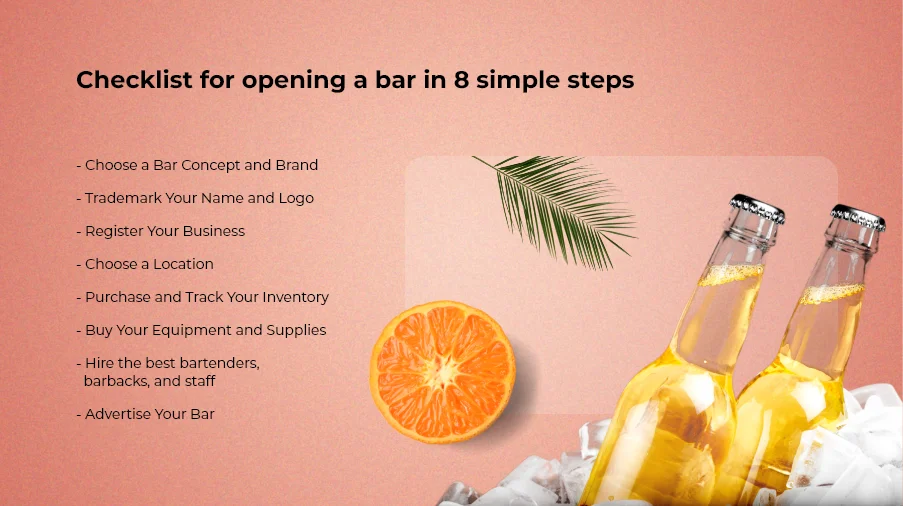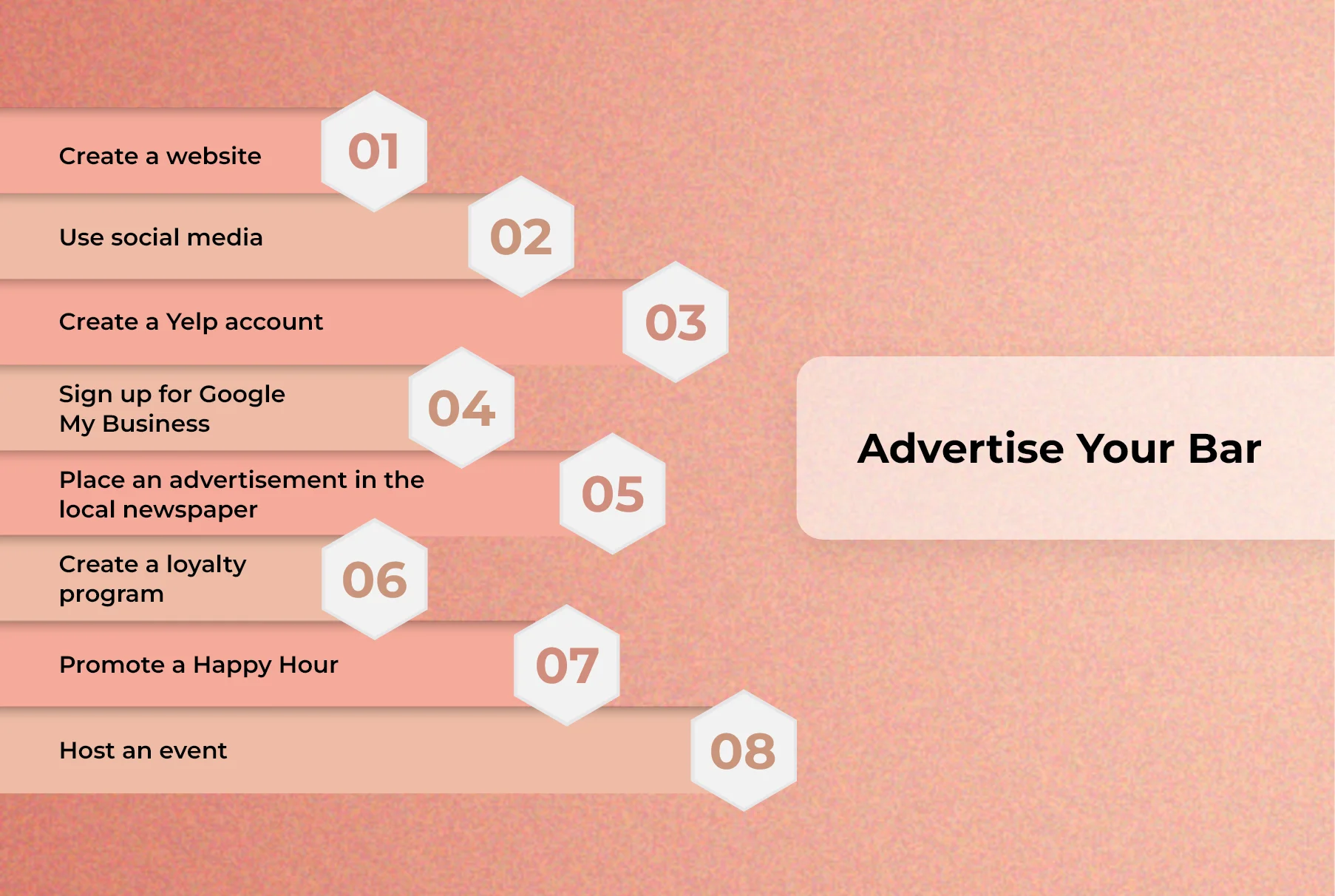Checklist for opening a bar in 8 simple steps
Opening a bar is rewarding because bars are often profitable businesses that can thrive for years. And opening a new bar demands grit and determination, as well as an excellent bar business plan to serve as a road map. This document will decide the future success of your new venture; thus, it must be as comprehensive as possible.
Check out this bar opening checklist to give your bar the best chance of success.

Creating your concept and brand is the fun aspect of starting your own bar. Your concept covers all of your general thoughts regarding the type of bar you wish to open. Your brand is more defined and encompasses your company's identity and mission. Every detail of your bar, from service to decor and ambiance, should support your brand. What do you want customers to feel when they walk into your bar?
Here are some ideas for bar concepts to get you started on your own:
- An unpretentious neighborhood bar with cozy booths and a jukebox full of classic tunes where people can unwind after work.
- On a Friday night, a barcade with vintage pinball games offers only a few types of beer, allowing guests to let loose and have fun.
- A dramatic martini bar with neon lights and seductive music, where customers can feel like they're in an exclusive club.
- A classy wine bar with modern furnishings and wall art, where guests can sip flights of wine paired with appetizers.
The most important thing to remember is that your concept and brand should align with the demographics of your chosen location. When it comes to conducting market research, you may need to modify your brand to match the needs of the neighborhood you are serving.
2. Trademark Your Name and Logo
While using a trademark protects your bar's name or logo within a specific geographic area, it is difficult to enforce protection without registering your trademarks with the United States Patent and Trademark Office (USPTO).
To trademark your name and logo, I would recommend engaging an intellectual property attorney rather than going at it alone, as the trademark process is quite complicated.
Before trademarking a logo, make sure the logo designer also grants you the copyright, or at least the right to use the logo for your business.
3. Register Your Business
You can't run a business unless you're properly registered. The procedures for registering your bar vary depending on the city and state where your business operates. But like with any new business, you'll need to obtain an employer identification number for tax purposes and register your company with local authorities.
You will also need to select a suitable business entity type. The four most common entity types, or legal formations, are:
- Sole proprietorship
- General partnership
- Corporations
- Limited liability corporations
While sole proprietorships and general partnerships are the easiest businesses to set up, they do not provide personal liability protection, which means that if your business is sued, your personal assets may be seized. Because bars are more legally risky than other businesses, you might consider forming an LLC or corporation. An expert business attorney can assist you in making the right selection for your bar.
4. Choose a Location
Location is everything. Before deciding on a location for your bar, consider the following factors:
- Your Style: Is your style formal? Elegant? Casual? This can influence the types of customers you're likely to attract.
- Demographics: Different parts of your city appeal to different demographics. If you want to attract college students, open near a university. Set up shop in a more affluent area of town if you want to attract upper-class customers.
- Accessibility and Parking: If you're attracting tourists, parking is less of an issue because they're more likely to call a cab or use Lyft or Uber. Tourists, on the other hand, are less likely to return. Keep this in mind when choosing your location.
- Zoning Restrictions: Can you open a bar here?
- Rent and utility costs: will you be able to make up for this in sales if you attract the right customers?
5. Purchase and Track Your Inventory
Bar inventory is an important part of keeping track of your cost of sales (including liquor costs, food costs, and other products), so make sure you set up a process for this before you open or use a bar point-of-sale system that integrates with your favorite bar technology providers, such as:
- BevSpot
- SteadyServ Technologies
- Avero
Proper inventory tracking can help you set prices and determine which things in your bar are the most profitable. You can use this information to help bartenders make more effective drink recommendations, boost your bar's profit margin, and price your bar menu for profitability.
6. Buy Your Equipment and Supplies
To serve drinks, you'll need to stock your bar with some basic equipment. It is important to consider the space and electrical needs for these items:
- Bottle Coolers – These back bar coolers hold all the bottles and cans you'll need to keep refrigerated. The bottle chiller should ideally be placed under your bar so that bartenders can easily access it.
- Ice Machines – It will require a lot of ice to keep the drinks flowing at your bar. To produce large volumes of ice throughout the shift, you'll need a dependable ice machine.
- Ice Bins – Once your ice machine makes the ice, you'll need to store it somewhere suitable for your bartenders. Under-bar ice bins are intended to fit beneath the bar and provide easy access to ice for cocktails and blended drinks.
- Glass Washer – Having a glass washer under the bar is really convenient. Some variants are designed to fit within an underbar sink and require no electricity.
- Bar Blender- For popular blended drinks like daiquiris and margaritas, you'll need a dependable, commercial-grade bar blender. Look for a model with a cover to reduce noise while blending.
- Beer Dispensers – A bar isn't complete without a beer dispenser. The beer is dispensed through a tap tower on top of the dispenser, which is housed in a refrigerated cabinet.
In addition to your bar equipment, you'll need to stock up on other bar basics. Make sure you have the proper glassware to serve your beverages. Depending on your menu, you might need garnishes, drink ingredients, and cocktail mixes. Cocktail napkins, coasters, and stirrers will be needed for your bar top.
7. Hire the best bartenders, barbacks, and staff
Your bar will fail if you do not hire the right staff. Great bartenders are creative, driven, and excited to come to work every day. And, if you offer table service, alcohol training for waiters is essential.
Because bartenders are the face of your business, you should employ them based on expertise and personality fit. To find excellent candidates, you can use sites such as:
- Harri
- Poached Jobs
- AllBartenders.com
When hiring, don't forget about barbacks: the unsung heroes of the bar.
Once you have a great team, rely on them to find you more candidates. The best employees generally come from an established network; great bartenders know great bartenders.
Keep your bartenders motivated and delighted by showcasing their creations on social media or entering them in bartending competitions and awards. And never stop learning: bartender training is vital for developing your ambitious bar team into genuine hospitality professionals.
8. Advertise Your Bar
You've done your research and are now ready to announce your new bar to the community. This is where advertising and marketing your bar come into play. Here are some ideas for informing potential customers about your business and building excitement for your opening day:
1. Create a website – Creating a website for your bar is vital. Many customers do online research before making a visit, so you should provide key information on your site. Your website should also reflect your brand.

2. Use social media – Another strategy to reach out to potential customers is to create accounts on social media sites such as Facebook, Twitter, and Instagram. You can post high-quality images of your specialty cocktails and promote specials.
3. Create a Yelp account – Create a Yelp business profile so that you can increase your online presence and allow customers to leave reviews for your bar. You can directly ask your guests to give reviews by including a request on your bar receipts

4. Sign up for Google My Business – Google My Business is a free service that ensures your restaurant's information shows up in Google searches and on Google Maps. Make sure to provide as much information as possible, such as your website, hours, photos, and price ranges.
5. Utilize your storefront – While you're building your new bar, people will be naturally curious about your new business. Make use of posters and pavement signs to convey information about your bar and the opening date.
6. Place an advertisement in the local newspaper – Purchase advertising space in the local newspaper to promote your new bar. You could even include a half-price drink coupon.
7. Create a loyalty program – Sign up for a mobile app loyalty program and reward your guests for their continuous support. If you specialize in craft beers, it offers a way for guests to track and rank the beers they've tried at the bar.
8. Promote a Happy Hour – Using low-cost drink promotions, happy hours are an ideal way to attract customers. You can also provide free samples and snacks.
9. Host an event – There are a lot of events you might host in your bar to create buzz. Consider holding a wine tasting if you own a wine bar. If you own a tap house, trivia nights might be a great way to attract new customers. Don't forget about your grand opening!

